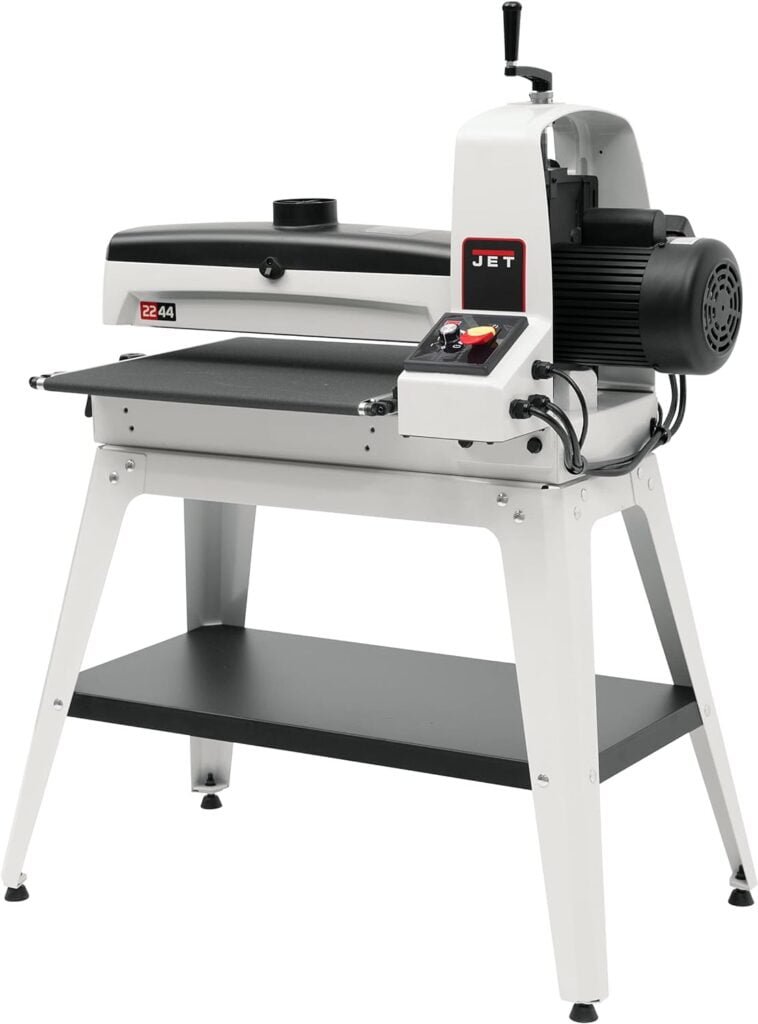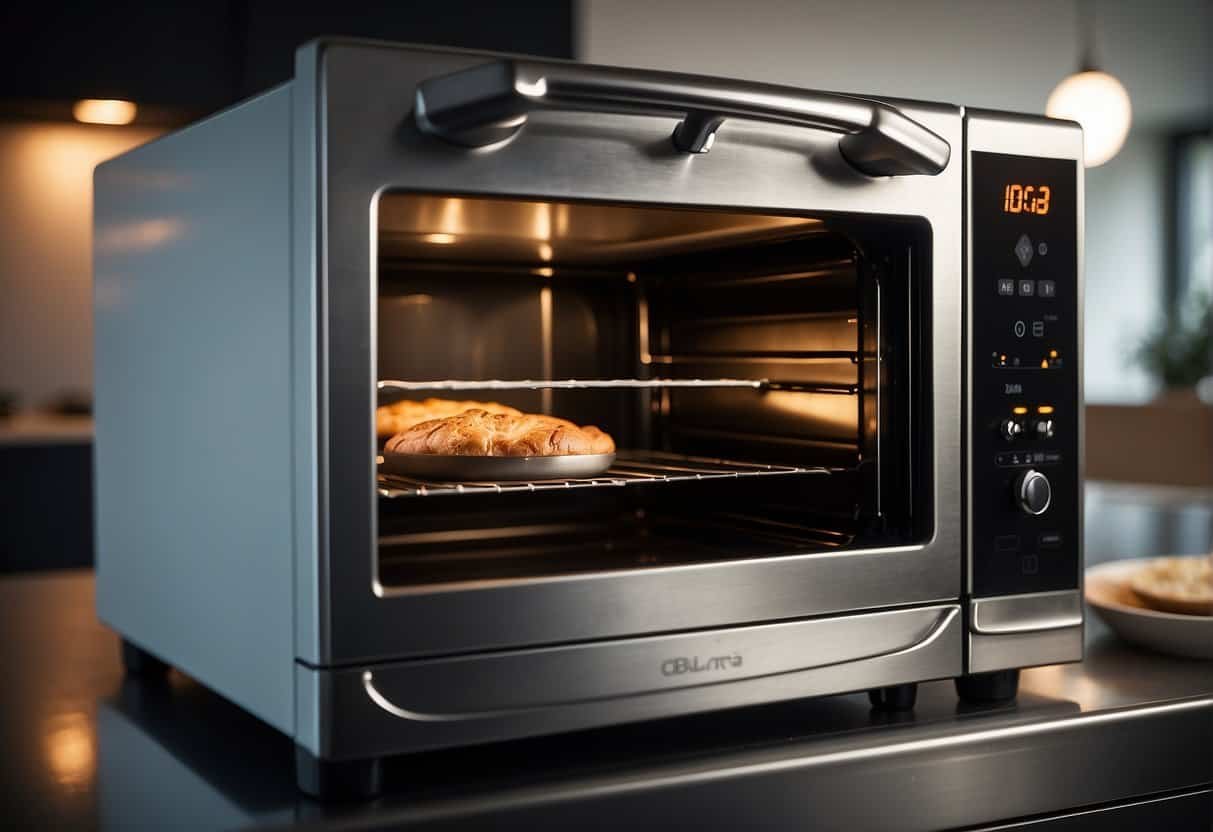Table of Contents
Drum sanders are highly useful machines for any woodworking shop. However, the typical heavy-duty approach to their design often means it’s difficult to find the perfect option for small shops and home workshops. What are the best options on the market now?
The best drum sanders for small shops include the JET JWDS-2244 22″, SHOP FOX W1740, and the Powermatic PM2244. The Shop Fox W1740 design is one of the most affordable drum sanders for a small shop, while the Powermatic PM2244 is the option to go with for more demanding cabinetry projects.
The rest of this article will take a closer look at each of these products and how they fit for different applications. We will also talk about their pros and cons.
Best Drum Sander for a Home Shop
JET JWDS-2244 22″ Drum Sander

If you’re looking for a drum sander that’s powerful enough to simplify your sanding in your home shop but won’t take up a lot of space, the JET JWDS-2244 is an excellent option to go with. The machine has a compact design and comes with a durable stand. Once set up, you can move it around the shop easily (Source: Amazon).
The JET JWDS-2244 is widely known for the Sandsmart technology, saving you the time normally spent looking for an optimal sanding speed. It constantly monitors the motor’s load and automatically sets the perfect speed to get the job done. You can also adjust the conveyor bed parallelism pretty quickly by turning the dial located on the outside of the bed. You don’t need any special tools.
This drum sander is dynamically designed to dissipate heat while you work. That means you don’t have to worry about shutdowns or burnouts when you have a lot of work to do. You also won’t have to waste any time waiting for the machine to cool down between tasks.
The machine comes with an integrated, efficient dust collection chamber so that you can sand without getting dust and debris in every corner of the shop. This is important for a home shop that most likely houses other equipment and projects in progress.
The motor on this drum sander operates at 115 volts, and assembly is straightforward, so you won’t spend a lot of time going over the instruction manual. Overall, this is an excellent drum sander that always delivers excellent performance.
Pros
- It has a compact build.
- There’s a built-in dust collection port.
- The Sandsmart technology ensures optimal speed selection.
- There’s a 5-year warranty.
Cons
- The stand legs may be too wide in some spaces.
Best Drum Sander for a Small Shop

SHOP FOX W1740 12-Inch Drum Sander
There aren’t many drum sanders around the 12-inch (30.48-cm) range, making Shop Fox W1740 one of the most recommended options for drum sanders that can fit in a small shop. Whether you’re working from a home shop or a small commercial space, this sander has the perfect design for that kind of space.
The sander comes with a self-feeding system, and the 12” (30.48 cm) wide drum is designed to accommodate sanding small wood pieces with thicknesses up to 3 ¾” (1.91 cm) (Source: Sander Review). The size of the sander is why it also doubles as a planer for some people. You can always count on it when removing blemishes and scratches.
This powerful sander has a 4” (10.16 cm) drum and a 2 ½” (6.35 cm) dust can, but it’s still small enough to fit in any small space you can find in the shop. The dust collection port is surprisingly as good as what you’ll find on many high-end models. Installing and replacing sandpaper on this product is straightforward, as the machine accepts both hook and loop sanding rolls.
This is an all-around quality drum sander that can get the job done in most small home or commercial shops. However, it’s not an option to consider if you’re looking for a sander that can take every size of wood you throw at it.
The machine is designed only to handle wood pieces that are no more than 12-inches (30.48 cm) wide. If you regularly work with pieces wider than this, it may be best to explore other options.
Pros
- It has a compact design.
- The dust collection port is super useful.
- Sandpaper replacement is straightforward.
- It comes with a variable speed knob that can take feed rate from 2.47–17.3 FPM.
Cons
- Rubberized mechanisms can give way with constant use.
- No warranty offered.
Best Drum Sander for Cabinet Shop
Powermatic PM2244 Drum Sander

The Powermatic PM2244 is a robust sander with a 1¾ HP motor. It’s powerful enough for most non-heavy duty cabinetry and furniture work. The motor is housed in a durable cast iron carriage—a rare feature seen in drum sanders in this category. You’ll also find four dust collection ports under the steel hood (Source: Amazon).
Another interesting feature of the Powermatic PM2244 is the LED control panel. Inputting your preferred speed, power, and other such control-related information is an easy task. It gives the machine a modern feel, ensuring that all the relevant controls are in one window.
The machine’s sturdy build is a positive, but it can also be considered a con if you want a drum sander that can move around easily. The cast-iron carriage means that the machine weighs around 300lbs (136kg).
Overall, this is a solid drum sander that’s just about enough for most DIY and professional applications. It won’t do much heavy-duty work, but those aren’t typically expected of drum sanders in this range.
Pros
- It has a very high build quality.
- There are multiple dust collection ports.
- The digital controls make management easy.
- It has a powerful motor.
Cons
- The machine is too bulky.

What To Look For in a Drum Sander
When looking for a drum sander, there are a few important factors to watch out for. They include the following:
The Motor Power
The motor power of your drum sander is directly proportional to the performance you can expect from it. Pay attention to this when you’re looking for a model to buy. The motor power is usually given in Horsepower (HP).
You’ll find many models marketed as 1 HP or 1½ HP sanders. These are usually enough for most DIY projects and professional applications that don’t qualify as heavy-duty.
If you want a drum sander that can effortlessly excel at the heavier stuff, you should aim for options with a 5 HP rating and above.
However, keep in mind that higher motor power also translates to more power consumption. Some of the newer models on the market today are striving hard to ensure efficiency, but this is a factor you can’t ignore.
Overall Drum Size
You won’t find many manufacturers detailing the drum size for their sanders, but it’s a factor worth paying attention to. It’s important because a large sanding surface typically offers a high contact surface area for sanding projects.
Average drum sanders have their drum sizes between 10 to 22 inches (25.4 to 55.88 cm), but you can also find some bigger-sized options for heavy-duty projects.
Overall Form Factor
Not many people buy drum sanders for portable use, but it’s still important to ensure that your chosen option has the right form factor for your specific needs. For example, if you have a small shop where space is at a premium, you’d want to choose a sander that won’t take up any more unnecessary ground.
Also, how will you transport your sander when you want to relocate? Or when you have to work somewhere outside your shop for a while? You have to strike some kind of balance between the sander’s overall size and form and the performance promised.
Manufacturer Warranty Offered
Many drum sander models on the market have a manufacturer’s warranty. You should check yours to see what they’ve offered (paying attention to any clauses). Drum sanders are a pricey investment, so it helps to know that you can get some resolution from the manufacturer when there’s a defect.
Some warranties may also reduce your expense when it’s time to maintain or repair the machine in the future. Most manufacturers offer a 1-2 year warranty, but on some of the more durable and more expensive models, they can go up to five years.

How Much Wood Does a Drum Sander Remove?
A drum sander will typically remove about 0.004″ to 0.009″ (0.01 to 0.02 cm) of wood per pass (Source: Rockler).
The exact quantity removed will come down to factors like the machine’s power and the speed setting it’s working at. However, generally, drum sanders don’t remove wood as fast as a planer.
Will a Drum Sander Flatten Boards?
No, a drum sander will not flatten boards (source: Reddit). These are not designed to correct such major imperfections; that’s the job of a planer. Think of your drum sander as a higher-powered orbital sander.
Even the most heavy-duty models will not flatten a board with major warps or other similar problems.










